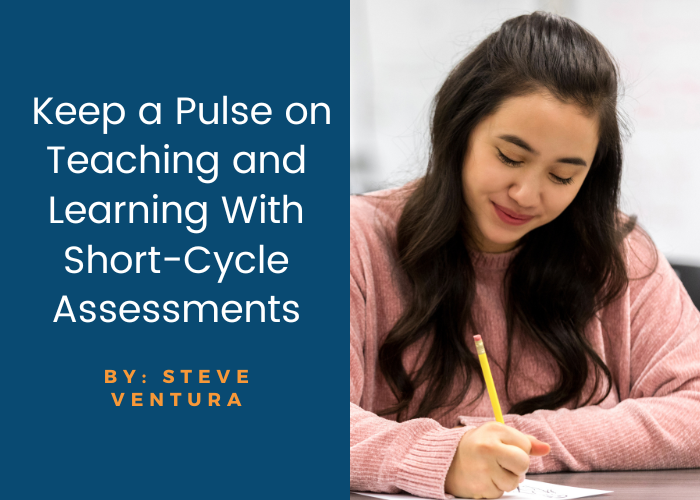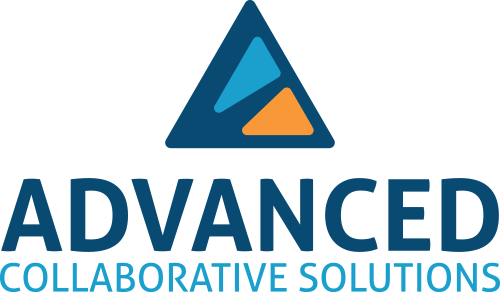Keep a Pulse on Teaching and Learning With Short-Cycle Assessments

By: Steve Ventura
With such an emphasis on end-of-year standardized testing, it is understandable why many students see grades and performance as some sort of permanent label on them as a learner. What if we shifted our focus to short-cycle assessments that keep a pulse on standard mastery and changed our view of learning from being a destination to being instead a lifelong journey? When educators and their teams collaborate using our four-step achievement model and follow a coherent flow of pre-, formative, and post-assessment, student achievement, teacher effectiveness, and staff culture improve.
Read on to learn about the importance of short-cycle assessments and get guidance in creating and leading the implementation of your own.
Achieving School’s Most Essential Goals
What if I told you that you could achieve the following goals:
- Meet the learning needs of every student
- Develop students’ ability to self-evaluate and independently diagnose their own strengths and areas of growth
- Cultivate motivation and intentionality for learning in your students
- Focus educators’ energy on instructional practices proven effective with the unique students they serve
All these are possible through short-cycle assessment implementation. Let’s dig in a little deeper.
What Are Short-Cycle Assessments and What Are They Not?
In our new book Achievement Teams: How a Better Approach to PLCs Can Improve Student Outcomes and Teacher Efficacy, we define short-cycle assessments as the following:
“Short-cycle assessments are pre- and post-assessments that teachers can administer anywhere from two to four weeks apart. Teachers often administer these before the end of a unit of instruction; they typically don’t grade them because of their formative purpose. The assessments provide initial baseline information that teachers can use to create instructional planning for individual students as well as for an entire class.”
Specifically, we recommend 6-10 items for each learning target, assessing no more than 1–2 targets (check out an example here). After administering short-cycle assessments, educators reflect on the following focus questions to instruct intentionally moving forward, further developing a culture of continuous learning on your teaching teams:
- What strengths and gaps do the assessment results show?
- What skills (verbs) and concepts (nouns and noun phrases) were achieved from the learning target, and what still needs to be learned?
- Who did we teach effectively, and who still needs help?
- Which instructional strategies were effective? Which ones were less effective?
Educators are not the only ones who benefit from reflecting on short-cycle assessment data. In fact, the real magic happens when students review their performance on formative tasks and ask themselves: Where am I now? What did I learn? What are my next steps? How am I going to reach my goal?
Imagine a classroom full of students who view learning as a process, rather than an arbitrary final destination. Developing this level of self-awareness as a learner will benefit them far beyond their time in school.
It is essential to note that short-cycle assessments are not at all intended to assess every standard you teach. Instead, these assessments are intended to focus on highest-priority learning targets (read more in this blog) to concentrate instructional time on the standards that matter most for student success.
From Theory to Action: Implementing Short-Cycle Assessments
Within the broader scope of the ongoing and iterative Achievement Teams meeting protocol, short-cycle assessments set the groundwork for instructional leaders to guide teacher teams through our four-step model (request your free Achievement Teams Protocol Template here). Chapters 5-8 of our new book dive into this protocol in helpful detail, but as an overview, implement these steps for stronger student achievement:
- Step 1: Collect and chart the short-cycle assessment data.
- Step 2: Set SMART goals.
- Step 3: Create baseline evidence statements.
- Step 4: Select high-yield instructional strategies.
Let’s be clear about the differences between short-cycle and benchmark or interim assessments. While an essential part of a healthy assessment approach, benchmarks or interims are most helpful when they align to and support short-cycle formative assessment. So for example, imagine your end-of-quarter benchmark assessment measures mastery on ten standards. During this ten-week quarter, you could hypothetically run five short-cycle assessment rounds (each lasting two weeks) and hone in on two of those ten benchmark standards incrementally. This intermittent short-cycle data will paint a clear picture of student learning needs and corresponding teaching strategies to get students to mastery by their quarterly assessments.
This type of well-oiled assessment machine is rarely accomplished immediately. Just like we ask our students to approach learning as a process, we must give our teacher teams the same grace and time to succeed. As an introduction to this framework, ask educators to select one subject or class to focus on. In ongoing PLC meetings, guide teacher teams as they discuss and analyze short-cycle assessment data. With this level of clarity in student performance, teacher teams better meet the unique needs of all students, promoting a culture of equity and growth.
Help Your Students and Educators Achieve
This is just the tip of the iceberg for those who want to revolutionize student and teacher success in their school. If the short-cycle assessment approach piques your curiosity, explore Achievement Teams: How a Better Approach to PLCs Can Improve Student Outcomes and Teacher Efficacy and start leading your students and teachers to success!

